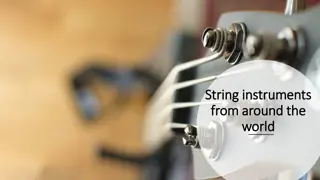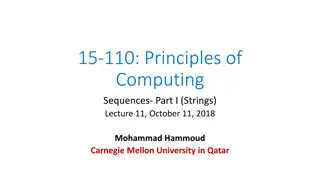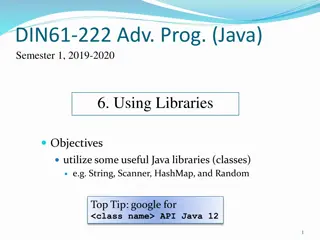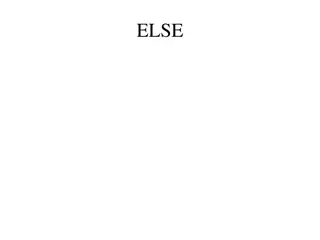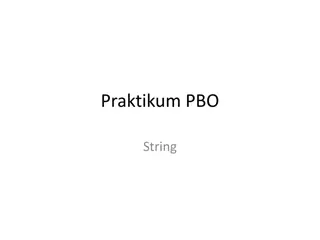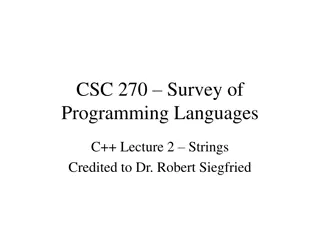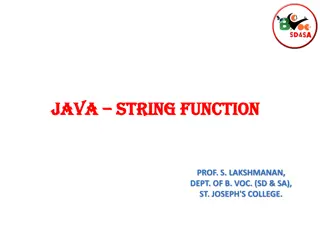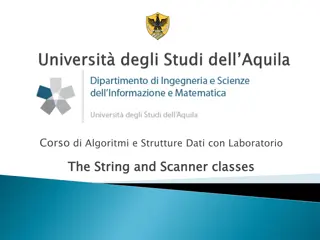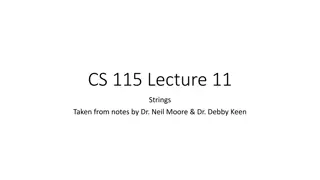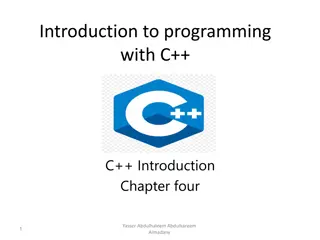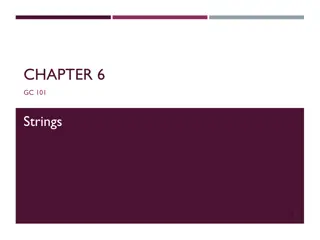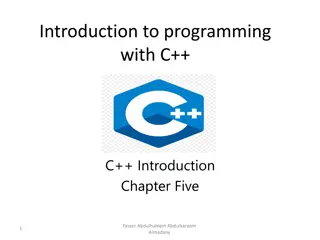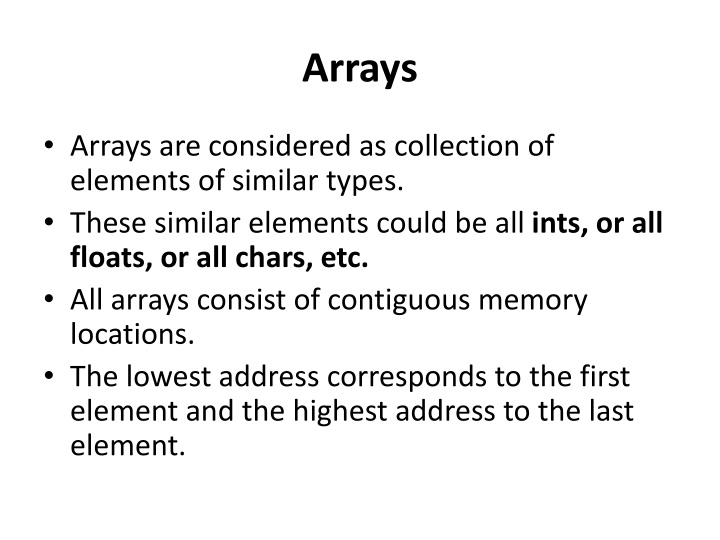
Arrays in C++ Programming
"Learn about arrays in C++: declaration, accessing elements, important points to remember, array initialization, inserting and printing elements, and passing array elements to a function."
Download Presentation

Please find below an Image/Link to download the presentation.
The content on the website is provided AS IS for your information and personal use only. It may not be sold, licensed, or shared on other websites without obtaining consent from the author. If you encounter any issues during the download, it is possible that the publisher has removed the file from their server.
You are allowed to download the files provided on this website for personal or commercial use, subject to the condition that they are used lawfully. All files are the property of their respective owners.
The content on the website is provided AS IS for your information and personal use only. It may not be sold, licensed, or shared on other websites without obtaining consent from the author.
E N D
Presentation Transcript
Arrays Arrays are considered as collection of elements of similar types. These similar elements could be all ints, or all floats, or all chars, etc. All arrays consist of contiguous memory locations. The lowest address corresponds to the first element and the highest address to the last element.
Declaring Arrays The syntax for declaring an array is: dataType arrayName[arraySize]; Data type of array For example: int marks[10]; double avg[20]; char name[20]; Name of array Size of array All elements of int type All elements of double type All elements of char type
Access Elements in C++ Array Each element in an array is associated with a number called as an array index. The elements of an array are accessed by using those indices. for example-consider the array int x[6];
Important points to Remember The array indices start with 0. Meaning x[0] is the first element stored at index 0. If the size of an array is n, the last element is stored at index (n-1). Meaning that elements are stored from x[0] to x[n-1] indices of the array x of size n. Elements of an array have consecutive memory addresses and the size of each element is increased by 4. Meaning that if the first element is addressed at location 1000 then second element is stored at 1004 and third is at 1008 and so on
Initialization of Array in C++ Array elements can be initialized at the time of declaration of the array as int x[6] = {19, 10, 8, 17, 9, 15}; Other examples are: int n[ ] = { 2, 4, 12, 5, 45, 5 } ; float press[ ] = { 12.3, 34.2 -23.4, -11.3 } ;
Inserting and printing elements main() { int numbers[5]; cout << "Enter 5 numbers: " <<endl; for (int i = 0; i < 5; ++i) { cin >> numbers[i]; } cout << "The numbers are: "; for (int n = 0; n < 5; ++n) { cout << numbers[n] << " "; } }
Passing array elements to function #include <iostream> using namespace std; void display(int); main( ) { int i ; int marks[ ] = { 55, 65, 75, 56, 78, 78, 90 } ; cout<< "Marks are:"<<endl ; for ( i = 0 ; i <= 6 ; i++ ) display ( marks[i] ) ; } void display ( int m ) { cout<< m<<endl ; }
Multidimensional Array Here the concept is array of array. For example consider: int x[3][4]; It is a 2 dimensional array contains 3 rows and 4 columns.
Initialization of two dimensional array int x[2][3] = {2, 4, 5, 9, 0, 19}; Not preferred int x[2][3] = { {2, 4, 5}, {9, 0, 19}}; Mostly preferred: this array has 2 rows and 3 columns.
Example of 2D array main( ) { } int num[3][3]; cout<< "Enter the Numbers:"<<endl ; for (int i=0;i<3;i++) { for(int j=0;j<3;j++) } cout<< "The Numbers are :"<<endl ; for (int i=0;i<3;i++) { for(int j=0;j<3;j++) { } cout<<endl; } cin>>num[i][j]; cout<<num[i][j]; cout<<" ";
Strings in C++ It is a character array. These are used by programming languages to manipulate text such as words and sentences. A string constant is a one-dimensional array of characters terminated by a null ( \0 ). For example: char name[ ] = { 'H', 'A', 'E', 'S', 'L', 'E', 'R', '\0' } ; Each character in the array occupies one byte of memory and the last character is always \0 .
Continue Note that \0 and 0 are not same. ASCII value of \0 is 0, whereas ASCII value of 0 is 48. The terminating null ( \0 ) is important, because it denotes that a string ends here. A string not terminated by a \0 is not really a string, but merely a collection of characters. char greeting[] = "Hello";
Example #include<iostream> using namespace std; main() { char s[]="Hello Santosh"; int i=0; while(s[i]!='\0') { cout<<s[i]; i++; } }
C++ supports a wide range of functions that manipulate null-terminated strings strcpy(s1, s2); Copies string s2 into string s1. strcat(s1, s2); Concatenates string s2 onto the end of string s1. strlen(s1); Returns the length of string s1. strcmp(s1, s2); Returns 0 if s1 and s2 are the same; less than 0 if s1<s2; greater than 0 if s1>s2. strchr(s1, ch); Returns a pointer to the first occurrence of character ch in string s1. strstr(s1, s2); Returns a pointer to the first occurrence of string s2 in string s1.
Example main () { char str1[10] = "Hello"; char str2[10] = "Santosh"; char str3[20]; int len ; // copy str1 into str3 strcpy( str3, str1); cout << "strcpy( str3, str1) : " << str3 << endl; // concatenates str1 and str2 strcat( str1, str2); cout << "strcat( str1, str2): " << str1 << endl; // total lenghth of str1 after concatenation len = strlen(str1); cout << "strlen(str1) : " << len << endl; return 0; }
Revision of Structures in C It is a collection of data of different types. A structure is a convenient tool for handling a group of logically related data items. It is a user defined data type. Once the structure type has been defined we can create variables of that type using declaration that are similar to the built-in types declaration.
Defining a structure Syntax: struct structure_name { data_type member_variable1; data_type member_variable2; ; data_type member_variableN; }; After declaring structure_name as new data type, then variables of that type can be declared as: struct structure_name structure_variable; Note: The members of a structure do not occupy memory until they are associated with a structure_variable.
Example struct student { }; struct student st; char name[20]; int roll_no; float marks; char gender; long int phone_no; Multiple variables of struct student type can be declared as: struct student st1, st2, st3;
Accessing member of structure Members of a structure are accessed by using dot (.) operator or period operator or member operator. Syntax: structure_variable.member Here, structure_variable refers to the name of a struct type variable and member refers to the name of a member within the structure. For example: st1.name st1.roll_no .
Example struct student { char name[20]; int roll; float mark; }; void main() { struct student s; printf("Enter name:\t"); gets(s.name); printf("\n Enter roll:\t"); scanf("%d", &s.roll); printf("\n Enter marks:\t"); scanf("%f", &s.mark); printf("\n Name \t Roll \t Mark\n"); printf("\n...................................\n"); printf("\n%s\t%d\t%f", s.name, s.roll, s.mark); }
Initializing Structure Members Structure members can be initialized when the structure variable is defined. For Example
Array of Structures If multiple structure elements are there then better way to create array of structure as:
Structures Within Structures We can nest structures within other structures.
Limitations of Structure Not providing the concept of data hiding. Not behaving perfectly like built in types. For example if t1, t2 and t3 are the variables of structure time then we can not write t3=t1+t2; Not much reusability of code. Lack of data encapsulation.
Difference between Class and Structure 1)Members In structure are by default public where as the members of class are private by default. 2) Structure cannot be inherited. But class can be inherited. 3) There is no data hiding features comes with structures but Classes do, private, protected and public. 4) A structure can't be abstract, a class can. 5) A structure is a value type, while a class is a reference type. 6) A structure is contain only data member , but class contain data member and member function. 7) In a Structure we can't initilse the value to the variable but in class variable we assign the values. 8) Structure are value type, They are stored as a stack on memory. where as class are reference type. They are stored as heap on memory




